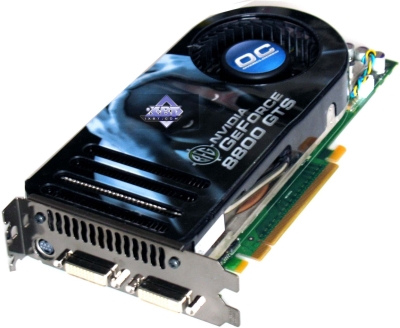Servicing the 8800GTS (320MB and 640MB) is recommended and is a relatively simple process that can be completed in as little as ten minutes however please be aware that if your card has any remaining warranty then you risk the warranty being voided so keep this in mind.
Equipment Needed
In order to service your card you will need the following items:
• Philips Screwdriver
• Citrus-based Solvent
• Can Of Compressed Air
• GPU Thermal Paste (recommend using Akasa or Arctic Silver for best results).
• An Old Credit / Debit Card (not essential but helps to apply the thermal compound correctly)
1. Remove All Screws From 8800GTS
Remove the 8800GTS from your system to begin with and lay this on a flat area with enough space to work. The standard 8800GTS heatsink has a total of 11 screws that need to be removed before it can be separated from the printed circuit board (PCB).
Firstly remove the 8 screws from the underneath of the card (be sure to keep all screws in a safe place). Then you will need to remove 2 further screws located near the monitor output sockets (these will be DVI ports and will be white in colour). The last screw can be found on the top corner of the card, joining the metal PCI slot into the circuit board itself and once this has been removed you will now be able to proceed to the next step.
2. Remove Heatsink
The vast majority of 8800GTS cards have an excess of thermal paste applied to them in the factory and consequently when you come to remove the heatsink you may notice that it does not initially want to come off despite the fact that you have removed all of the screws. This is quite normal and is simply a case of the thermal paste hardening over time and forming a light bond between the heatsink and PCB.
The best thing to do is use your screwdriver as a lever between the two and gently apply pressure to separate the two components (be careful to position the screwdriver so it does not touch the memory modules or capacitors on the PCB). Once the two parts are separated you will need you will see that they are connected only by a thin wire from the fan. Locate the plastic connection at the end of this wire where it plugs into the PCB and gently wiggle this to unplug the cable from the PCB.
3. Use Compressed Air to Clean Heatsink and PCB
Now that the heatsink has been removed you should use your can of compressed air to thoroughly clean the fan and metal fins on the heatsink and the surface of the PCB itself. I would advise doing this outside if possible as there may be a good deal of dust trapped within the heatsink, particularly if the card is quite old.
4. Remove Old Thermal Compound
Using a piece of kitchen paper to remove the majority of thermal compound from both the PCB and the copper plate located on the heatsink. Then use a citrus-based compound on a cloth (or cotton bud), to gently remove the last remaining traces of compound from both surfaces.
5. Apply New Thermal Compound
This stage can be a little tricky but the aim is to get a thin, even covering of compound on the copper section of the heatsink. I find the best way to do this is to apply a small (pea-sized) amount of thermal paste to one corner of the copper plate and use an old credit card to gently smooth it over the whole area. Don't use too more than this because the compound is nothing more than a very thin layer between the copper and the GPU core designed to fill in any surface irregularities on the metal (on the micron level).
6. Plug In GPU Fan Connector and Re-Attach Heatsink
Before re-attaching the heatsink be sure to connect the white fan cable back into the PCB. Now align the heatsink with the screw holes located on the PCB and reattach the 8 screws on the underside of the PCB. Make sure that these screws are tightened and that there is a good (flush) contact between the heatsink and PCB. Now attach the remaining 3 screws.
7. Test GPU Temperatures
Fit the 8800GTS into your system and power on as per usual. Before launching any 3D application I would recommend downloading a GPU temperature monitoring program such as Rivatuner and checking the idle temperatures of your card. You should see an idle temperature of anything between 30-55 degrees (centigrade) - any higher than this and I would suggest removing the card and double-checking that the heatsink is making good contact with the PCB.
Finally if the idle temps look okay then launch a 3D application such as a game or graphical benchmark and check the temperatures under load (should be under 90 degrees but likely will be around 70-85). Again if the temperature rises above 90 then this may indicate the heatsink is not fitted correctly or you have failed to reattach the GPU fan.
Final Thoughts
After you have serviced your 8800GTS correctly you may notice a reduction in both load and idle temperatures (and possibly fan noise). Performing this simple procedure once every 6-12 months should keep your 8800GTS running cooler and can help to extend its lifespan considerably.
David Hughes works as a repair engineer for [the website opalpcsolutions.co.uk cannot be found].

Learn more at amazon.com
More Windows Troubleshooting Articles:
• Get Remote Technical Assistance
• How to Fix Advapi32 Error
• MSCORSVW.EXE Hogging CPU resources?
• Video - Common Laptop Problems
• How to Fix RpcRtRemote.dll Errors
• How To Repair Hard Drive Problems
• Hard Drive Does Not Boot
• Diagnose a PC's Multimedia Functions
• Your Computer Can't Keep Time
• Free Open Source CPU Temperature Monitor

